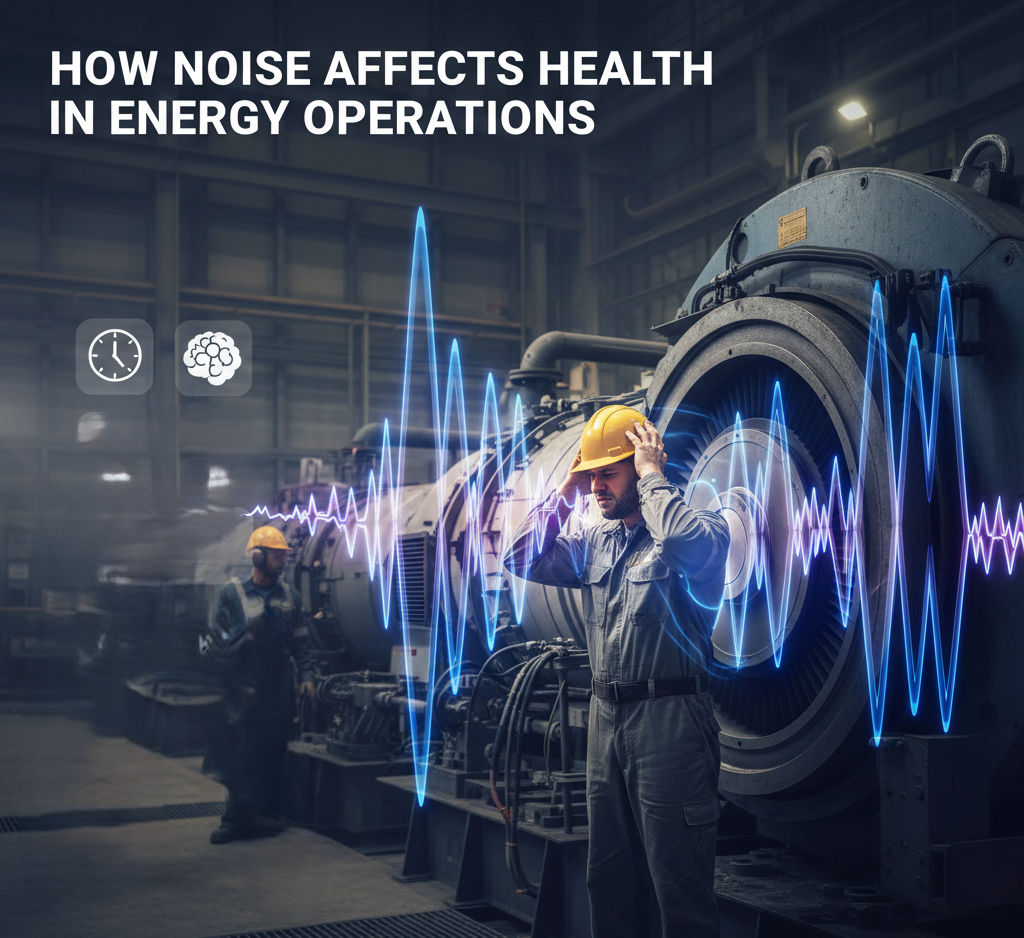
It’s Not the Air or Water This Time
When people think of pollution in oil and gas operations, they imagine flares, emissions, or contaminated water. But environmental noise in oil and gas is an invisible pollutant spreading across drilling sites — one that science is only beginning to understand.
A scientific review on unconventional oil and gas development reveals that continuous noise from drilling rigs, compressors, and hydraulic fracturing equipment can reach levels of up to 104 dBA — comparable to a chainsaw or a passing motorcycle. Unlike visible pollution, this noise creeps through walls, across fields, and into homes, disturbing sleep, raising stress levels, and increasing long-term cardiovascular risks.
Moreover, the research highlights that people living near well pads often experience intermittent but intense noise, especially at night. Even when residents no longer “hear” it consciously, their bodies do — triggering hormonal and cardiovascular responses.
AS a result, noise pollution, once considered a minor annoyance, is now emerging as a public health issue with measurable biological effects.
Imagine, for a moment, trying to rest while the low-frequency hum of industrial machinery vibrates through your walls. For many families living near drilling or compression sites, that’s everyday life.
In many reports, residents describe difficulty falling or staying asleep, constant fatigue, and reduced concentration. They also report increased irritability and stress.
These effects are not imagined — they are driven by physics and physiology. Prolonged exposure to low-frequency and high-decibel noise stimulates the body’s stress response, elevating cortisol levels and blood pressure. Over time, these biological reactions contribute to heart disease, anxiety, and decreased mental well-being.
Furthermore, communities closest to operations are disproportionately affected — including rural populations and workers spending long shifts onsite. The problem isn’t just annoyance; it’s about health equity, safety, and human performance.
Turning Noise Data into Safer Energy
At Acoustic Solutions Pte. Ltd., we believe sustainable energy production must include sound management.
Our mission is to help energy companies predict, measure, and control environmental noise before it affects workers or neighboring communities. Through advanced acoustic modeling and vibration diagnostics, we turn complex sound data into clear, actionable insights that enhance compliance, comfort, and trust.
That’s why our mission is to helpenergy companies predict, measure, and control environmental noise before it affects workers or neighboring communities. Through advanced acoustic modeling and vibration diagnostics, we turn complex sound data into clear, actionable insights that enhance compliance, comfort, and trust.
Our key services for oil & gas and renewable energy include:
✅ Environmental Noise Mapping: Predict how noise travels from rigs, compressors, and turbines using topographic and meteorological modeling.
✅ AIV/FIV Risk Assessment: Diagnose Acoustically-Induced and Flow-Induced Vibrations that threaten piping integrity in high-pressure systems.
✅ Mitigation Engineering: Design barriers, enclosures, and damping systems that target critical frequency bands (especially low-frequency noise under 125 Hz).
✅ Regulatory Compliance Support: Ensure projects meet World Health Organization (WHO) and local HSE acoustic standards, reducing the risk of complaints and penalties.
✅ Community Sound Monitoring: Provide real-time sound tracking to build transparency between operators and local stakeholders.
These solutions not only protect health but also improve operational stability — because systems designed for acoustic balance perform more reliably and efficiently.
Who This Matters To
This topic matters to every professional responsible for energy, environment, and safety:
- Project Managers & HSE Officers seeking to align with environmental noise compliance.
- Oil & Gas Operators managing drilling, fracturing, and compression facilities near populated areas.
- Renewable Energy Developers introducing wind and hydrogen projects in environmentally sensitive zones.
- Engineers and Architects designing acoustic mitigation into early project phases.
Ultimately, if your work connects technology and people, acoustics is part of your responsibility. The quietest systems aren’t just the most comfortable — they’re the most sustainable.
The Bigger Picture — Sound as a Sustainability Metric
As the energy transition accelerates, companies are being measured not just by their emissions — but by their impact on ecosystems and communities. Noise belongs in that conversation.
In fact, environmental noise affects biodiversity, disrupts wildlife communication, and undermines local quality of life. The Public Health Implications study calls for stronger regulation, better data, and proactive design to manage sound as a sustainability indicator.
By integrating acoustic engineering into ESG performance, industries can demonstrate leadership in responsible innovation.
Acoustic Solutions Pte. Ltd. partners with leading energy firms, offshore operators, and construction companies to deliver science-driven acoustic and vibration engineering.
From predictive modeling for offshore rigs to on-site diagnostics in refineries and renewables, our team ensures your projects not only meet standards — they set them.
Because sound matters, both to people and to the planet.
Contact Acoustic Solutions Pte. Ltd. today to integrate acoustic and vibration control into your next project.
Protect communities, enhance compliance, and build a quieter, healthier energy future.
